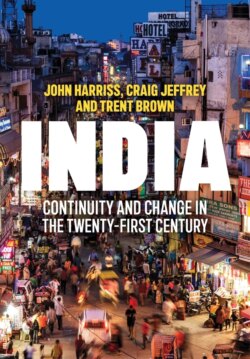India

Реклама. ООО «ЛитРес», ИНН: 7719571260.
Оглавление
Craig Jeffrey. India
CONTENTS
List of Tables
List of Illustrations
Guide
Pages
India. Continuity and Change in the Twenty-First Century
Abbreviations
About the Authors
Preface and Acknowledgements
1Making Sense of Twenty-First-Century India. 1.1 Introduction
1.2 Past and Present
1.3 The Impact of Colonialism in India
1.4 The Invention of Modern India. Democracy
Socialism
Secularism
Federalism
1.5 The Reinvention of India
2When and Why Has India’s Economic Growth Accelerated? 2.1 Introduction: Thinking About Economic Growth
Arguments about the Political Economy of Growth
2.2 India’s History of Economic Growth
2.3 Economic Growth 1950–1992: A Story of Failure?
Accelerating Growth in the 1980s
2.4 India’s ‘Economic Reforms’ and Growth in 1993–2001
2.5 ‘Superfast’ Growth, Slowdown and Questionable Recovery: 2002–2015
2.6 Conclusion
3How ‘Inclusive’ is India’s Economic Growth? 3.1 Introduction: Economic Growth and ‘Development’
3.2 Constructions and Measurements of Poverty
3.3 Poverty Trends in India
3.4 Durable Inequalities in Indian Society, Mobility and the Missing Middle Class
3.5 Conclusion
4Why Isn’t India Doing Better at Realizing ‘Inclusive Growth’? 4.1 Introduction: The Pattern of India’s Economic Growth
4.2 Has the Growth Process Ignored Indian Agriculture?
India’s ‘Agrarian Question’: A Brief History
Trends in the Agricultural Economy
Trends in the Lives and Livelihoods of India’s Rural People
4.3 ‘Jobless Growth’, ‘Excluded Labour’ and ‘Make in India’
4.4 Conclusion: Binding Economic and Social Constraints
5Can India’s Economic Growth Be Reconciled with Sustainability and Environmental Justice? 5.1 Introduction: The Costs of Environmental Degradation
5.2 The Environment and Development Debate: Must Growth Come First?
5.3 Environmental Conflicts: Capital, State, Civil Society and People
5.4 Environmental Policy and the Practice of Regulation
5.5 Conclusion
6Has India Become the Hindu Rashtra? 6.1 Introduction: ‘God Man’ to Government
6.2 The RSS, the BJP and the Struggle forHindutva
6.3 Temples, Gods and Gurus: Banal Hinduism, BanalHindutva
6.4 Banal Hindutva, Communal Violence and the State
6.5 Hindutva Rising
6.6 Authoritarian Populism and the Indian Case
6.7 Conclusion
7Is India’s Democracy at Risk? 7.1 Introduction
7.2 India as a Formal Democracy
7.3 India as Substantive Democracy 1947–2014. 1947–1990
1990–2014
7.4 Substantive Democratization Since 2014
7.5 Conclusions
8Why Hasn’t Democracy Made Indian Governments More Responsive? 8.1 Introduction: Economic and Social Rights and the Indian Constitution
8.2 The ‘New Rights Agenda’
8.3 From Rights Legislation to Implementation
8.4 Social Rights under the First Modi Government
Empowerment, or JAM today?
Welfarism, After All
8.5 How Government Works
8.6 Conclusions
9Is There a Countermovement against Neoliberalism in India? 9.1 Introduction: Polanyi’s Idea of the ‘Double Movement’ and India Today
9.2 Towards Social Movement Unionism?
9.3 Rural Struggles: Agrarian Crisis, and the ‘New’ Land Question
Adivasis, the ‘Mineral Rush’ and the Maoist Insurgency
9.4 Middle-Class Activism
9.5 Conclusions
10Is India Witnessing a Social Revolution? 10.1 Introduction
10.2 What is the Social Revolution?
10.3 Cultural Renaissance
10.4 Growing Prominence of Civil Society
10.5 Constraints on India’s Social Revolution
10.6 Conclusion
11Does Caste Still Matter in India? 11.1 Introduction
11.2 Caste in Mid-Twentieth-Century India
11.3 The Decline of Caste Hierarchies
11.4 Caste, Identity and Politics
11.5 Caste as Habitus: Hierarchy Revisited
11.6 Conclusions
12Why Does Gender Inequality Persist in India? 12.1 Introduction
12.2 Gender Relations and the Family
The Family and Gendered Violence
The Family and Unequal Sex Ratios
12.3 Gender Inequality in Education and the Workplace
12.4 Politicizing Gender Inequality
12.5 Conclusion
13Can Youth Transform India? 13.1 Introduction: Ideas about ‘Youth’
13.2 School Education
13.3 Higher Education
13.4 Unemployment
13.5 The Politics of Youth Unemployment
13.6 Conclusions
14Afterword: Is India Now a ‘Leading Power’? 14.1 Introduction: India’s Transformations and the International Arena
14.2 Coming in from the Margins: India in the World in the Late Twentieth Century
Indian Nuclear Policy
14.3 After the Cold War: An ‘Emerging and Responsible Power’?
How Much Difference Has Modi Made?
14.4 Conclusion: Still an Aspirant as a ‘Leading Power’
Glossary
References
Index. A
B
C
D
E
F
G
H
I
J
K
L
M
N
O
P
Q
R
S
T
U
V
W
X
Y
Z
POLITY END USER LICENSE AGREEMENT
Отрывок из книги
JOHN HARRISS, CRAIG JEFFREY
AND TRENT BROWN
.....
SOURCE: Election Commission of India
KEY: BJP = Bharatiya Janata Party; BJS = Bharatiya Jana Sangh; BLD = Bharatiya Lok Dal; BSP = Bahujan Samaj Party; CPI = Communist Party of India; CPM = Communist Party of India (Marxist); INC = Indian National Congress; JD = Janata Dal; JNP = Janata Party
.....